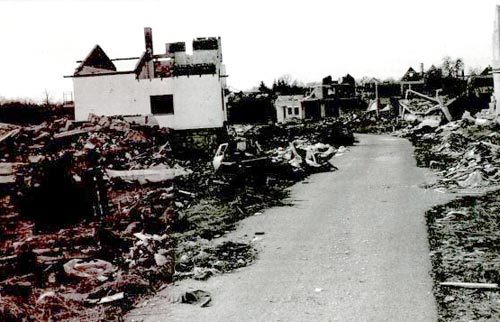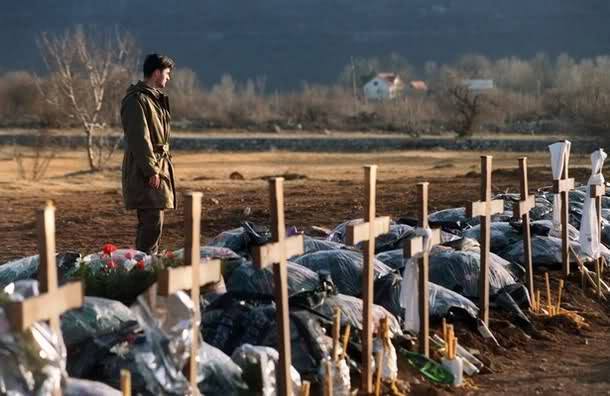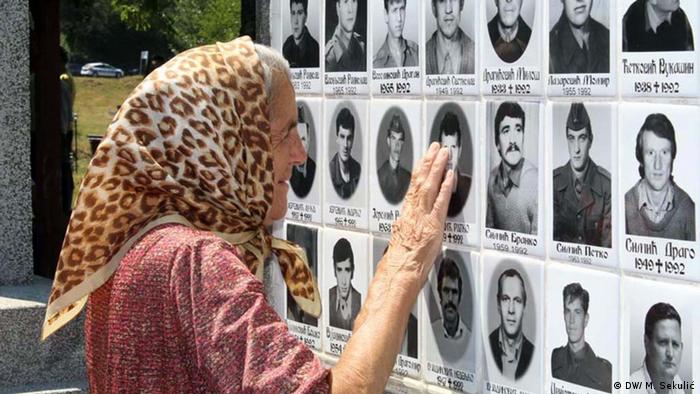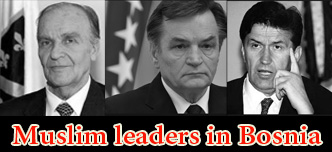Period:
Yugoslav Wars
Region:
Bosnia and Herzegovina
Sarajevo Golgotha - Exodus of Sarajevo Serbs - Bosnia 1996
Sarajevo Golgotha, known as the Exodus of Sarajevo Serbs, refers to the mass migration of nearly 150,000 Serbs from eastern parts of Sarajevo (Eastern Sarajevo), that began at the beginning of 1996 and lasted two and half months, until March 1996.
This exodus was a consequence of high treason from the Serbian delegation that went to the U.S. to sign the Dayton Agreement in the Autumn of 1995. Eastern parts of Sarajevo, which have been inhabited by Serbs mostly, were sacrificed in North America, for the alleged sake of "peace" and supposed international recognition of Republika Srpska — which actually meant creating two separate entities in Bosnia and Herzegovina in 51-49% ratio.
Today, Sarajevo is almost a Muslim city (with over 97% of Muslims) where Serbs are constantly being stripped out of their rights. Serbian heritage and existence are suppressed every day — even in front of international representatives.
It took twenty years for this exodus to be commemorated publicly and adequately in Bijeljina. Until then, it was only commemorated locally, in smaller towns where Sarajevo Serbs managed to escape: cities like Zvornik, Bratunac, Vlasenica, Brčko, Višegrad.
Over the summer and autumn 1995 during The Bosnian War, Serbs lost control over southern parts of Bosnian Krajina: those parts included Grahovo, Drvar, Glamoč, Petrovac, Mrkonjić Grad, Šipovo, Sanski most — under the aggression of Croatian forces. Afterward, the same fate followed parts of Central Bosnia including southern parts of Ozren mountain, river Krivaja, Vozuća, etc — under the pressure of Muslim invasion.
These actions by the so-called Army of Bosnia and Herzegovina were performed mainly using mujahedin, Croatian war units (HOS and HVO), as well as NATO alliance that bombarded many positions in the Republika Srpska during September 1995.
Signatories of the so-called “peace” were Izetbegović, Tuđman and Milošević
However, the Army of Republika Srpska managed to establish control over the territory of Srebrenica and Žepa in July 1995, in the region of Podrinje, precisely over east of Bosnia and Herzegovina.
BACKGROUND
With the disintegration of Yugoslavia, more than two million Serbs living in the area west of the Drina River found themselves beyond the borders of the Republic of Serbia. The disintegration of Yugoslavia in mid-1991 brought war and conflict, persecution and suffering, as Croatian separatists wanted, besides independence, to get an ethnically pure Croatian state.This would led to the realization of the milennial dream of Croats to get an independent Croatian state.

Village Divoselo was total destroyed
In the autumn of 1990, the Goverment of SR Croatia illegally imported a large number of weapons, and in the winter they changed the Constitution so to declare Serbs as a national minority. They erased the name "socialist" and a five-pointed chessboard became a symbol of Croatia. This led to the worsening of relations and tensions between Serbs and Croats because these symbols reminded Serbs of the terror they had experienced in the Independent State of Croatia (1041-1945). In the spring of 1991, Croatian police began raids in Serbian places and Serbs responded by raising barricades.
Federal Yugoslav Army - JNA served as a buffer zone until mid-summer 1991 when it was attacked by Croatian paramilitaries. Members of Ustasha (Croatian fascistic forces) and their descendants began to return to Croatia who emigrated after 1945 (Australia, USA, Canada, Spain, Germany, Argentina, Paraguay...)
Thus began the war that lasted for four years. During the war the Republic of Srpska Krajina was created, which included Northern Dalmatia, Lika, Kordun, Banija, Western Slavonia and Eastern Slavonia, Baranja and Western Srem.

Serbian cementery in Serbian Krajina
In April 1992, in the central Yugoslav Republic of Bosnia and Herzegovina, tensions began to intensify and a bloody war started between the three nations, which lasted for three years. This war led to creation of the Republic of Srpska neccessary for Serbs to avoid genocide they suffered during World War II.
Muslim and Croatian army units in Bosnia and Herzegovina committed lots of criminal actions, resulting in the ethnic cleansing of the Serbian population in Sarajevo, Srebrenica, Bihać, Mostar, Goražde, Tuzla, Orašje, Čapljina, Zenica, Visoko, Odžak, Duvno, Livno, Bugojno. Concentration camps were established for the torture of Serbs (Dretelj, Duvno, Čelebići, Sarajevo, etc.).

Image of Serbian victims from Eastern Bosnia
The Croatian Army and police during the war in Croatia (1991-1995), conducted series of criminal actions such as: "Miljevački plato", "Maslenica", "Medak Pocket". The ethnic cleansing of Serbs was conducted in urban areas such as: Sisak, Gospić, Zadar, Osijek, Vukovar, Karlovac, Zagreb, Split, Dubrovnik, and others.
The situation in Bosnia and Herzegovina
Bosnia and Herzegovina has been a central republic in SFR Yugoslavia characterized by multiculturalism until the outbreak of war. The multiparty election in 1990 brought a political environment in B&H, where figures with chauvinistic views advocated religiously and ethnically cleansed state. Leaders of Bosnian Muslims and Croats organized illegal arming at the end of 1991 and the beginning of 1992 when paramilitary units were formed- Patriotic League, Green Berretts, Croatian Defense Council.

Alija Izetbegović, Ejup Ganić and Haris Silajdžić
Muslim ruling representatives proclaimed the independence of Bosnia and Herzegovina on 3 March 1992, after the referendum failed several days earlier. Criminals from Sarajevo led by Ramiz Delalić Ćelo killed a groom’s father before a wedding ceremony at Baščaršija in the center of Sarajevo resulting in the splitting of the police in the city between Serbs and Muslims.
Croatian regular forces and paramilitary units of HVO attacked Serbs in Bosanski Brod at the end of March 1992, and several days later the same happened in Kupres. The war was thereby announced.

Serbian victims still waiting for juistice
In May 1992, the military vehicles of JNA were attacked while withdrawing from barracks. The first time this happened in Sarajevo on 3rd May, and then in Tuzla on 15th May. Muslim-Croatian joint forces in Bosnia and Herzegovina committed horrible crimes against Serbs in the period 1992-1993 in many locations: the valley of Neretva river, northern Herzegovina, the valley of Bosna river, the area of Bihać, the area of Srebrenica, areas of Sarajevo, Zenica, Goradžde, Tuzla, etc.
A lot of Bosnian and Herzegovina Serbs were detained in concentration camps such as: Dretelj, Ćelebići, Hrasnica, Viktor Bubanj, Central Prison, Silos, Odžak, Orašje, Derventa, etc.
DAYTON PEACE AGREEMENT
Even during the sanguinary civil war in Bosnia and Herzegovina and under pressure from the international community, Serbian, Croatian, and Muslim delegations were summoned to the U.S., precisely to the State of Ohio, where Wright-Patterson Air Force Base is located, right next to the city of Dayton.
Muslim delegation was led by Alija Izetbegović, military leader of Bosnian Muslims and the president of the so-called Presidency of Bosnia and Herzegovina; Croatian delegation was led by Franjo Tuđman, the president of the Republic of Croatia; while Serbian delegation was led by Slobodan Milošević, the president of the Republic of Serbia. Besides these leaders, the signers of this “peace” agreement (with their consent included) were also: Richard Holbrooke, the U.S. administration representative, and Wesley K. Clark, NATO alliance general.

Supervision of international diplomats over the Balkan pawns
Dayton peace negotiations lasted for 3 weeks, from November 1st to November 21st, 1995, when all global media brought to light the fact that this peace agreement was signed by each of the 3 delegations, that is the three nations that were at war in Bosnia and Herzegovina. Then, on December 14th, 1995, the agreement was permanently sealed in Paris and all of its stipulations and regulations started to apply.

All you can pack (in a bag)...
The three sides (Muslims, Croats, and Serbs) agreed that the Bosnian Serbs get Šipovo and Mrkonjić Grad, while 5 pre-war Sarajevo municipalities were given to Muslims — although no one from the negotiators in the U.S. asked for that.
Dissatisfied with these decisions from the Dayton agreement, on November 25th, 1995 in a place called Grbavica (that belonged to Sarajevo) Serbs organized mass protests and demonstrations against the decisions of the Dayton agreement, but unfortunately, that didn’t change those decisions. That meant that the whole of Sarajevo would soon be under Muslim control. This was literally “a spit in the face” of Serbs and Serbian fighters who gave their lives to defend the centuries-old Serbian land around Sarajevo.
EXODUS
By the Dayton or more precisely the Paris Agreement, five Sarajevo municipalities: Ilijaš, Vogošća, Ilidža, Hadžići, and Novo Sarajevo fell under the Muslim-Croatian Federation of Bosnia and Herzegovina. That is the mechanism by which the centuries-old territory that Orthodox Serbs inhabited and built was alienated.

"There is just a road sign left to remember us that we lived there"
The mass exodus of Serbs began in mid-February 1996, on the Orthodox holiday of Remembrance, because the planned exile of Serbs from this area should have been on 19 March 1996. Muslim extremists publicly told Serbs that they wouldn’t do well and that everyone would get what he deserved.
Foreign “peacekeepers” from the IFOR forces handed out leaflets stating that the date was moved to 23 February, a month earlier than agreed, which created panic. In addition to the fact that Serbian civilians had to pack the most necessary things and go into uncertainty, many inhabitants of Ilijaš, Grbavica, Hadžići, Ilidža, and Vogošće started digging out the remains of their dead ones, not wanting Muslim vandals to desecrate the graves of their loved ones.

We are not leaving the bones of our loved ones
Throughout the exodus, Serbian parts of Sarajevo were monitored from the air by IFOR helicopters that dropped leaflets with cynical messages from the famous poem by Aleksa Šantić “Ostajte ovdje” (“Stay here”). Writer, in fact, wrote it for Bosnian Muslims who were leaving for Turkey after the Austro-Hungarian occupation.
On the evening of 21 February 1996, the Serbian population from east Sarajevo municipalities went into exile carrying with them all they could. Serbian civilians were promised some trucks and buses for moving that day, but nothing came of it. TV stations rebroadcast columns. Almost 150,000 Serbs from Sarajevo went into uncertainty in snow, cold, and blizzard.

Sarajevans carried all that they could
On their way, Serbs were stoned in some places by their Muslim neighbors who behaved extremely inhumanely. IFOR members watched the exodus calmly from the sidelines.
On the way to Han Pijesak, a touching sight could be seen in those days - a carriage loaded with the most necessary things for starting a new life, with a visibly displayed Serbian tricolor, an icon, and incense lamp...

Terrible times to never happen again...
It was this exodus and migration that was hardest for Sarajevo Serbs of all the hardships that befell them during the 1992-1995 war because they could not take with them their houses, flats, air, streams, rivers, forests, Sarajevo hills…
CONSEQUENCES
Hardly any of the pre-war Serbs have returned to their hometown after all the horrors of the war. Muslim authorities did everything to make this return impossible through the legal and beaurocratic system. Also, the Muslim population in Sarajevo welcomed their ex-neighbors with great contempt. There were a lot of problems because the war was still going on in their heads. All these were more reasons for Serbs not to return to Sarajevo anymore, although there were almost 200,000 of them in the city on the river Miljacka before the war.
That is how Sarajevo Serbs went to Bijeljina, Zvornik, Višegrad, Belgrade, Novi Sa or abroad, mostly to the USA, Germany, Australia, France, Canada...
Every year in March, a memorial service is held in Bijeljina and Zvornik for the fallen warriors of the Army of the Republika Srpska from the territory of Sarajevo, as well as marking the exodus of Sarajevo Serbs.

At parting, the heart says: I’ll return...
PUBLICATIONS
In 1996, the journalist and television worker Snježan Lalović made a documentary entitled “Exodus repeated”, which shows authentic footage of the Sarajevo exodus and the testimonies of its victims.
At the end of 2020, the writer from Mali Zvornik, Nenad Milkić, published the novel entitled “Kosti” (“The Bones”) which deals with Sarajevo during the war of the 1990s, and the central part of the story is the Sarajevo exodus.

Kosti (The Bones) by Nenad Milkić
Tags:
Please, vote for this article:
Visited: 3202 point
Number of votes: 10
|